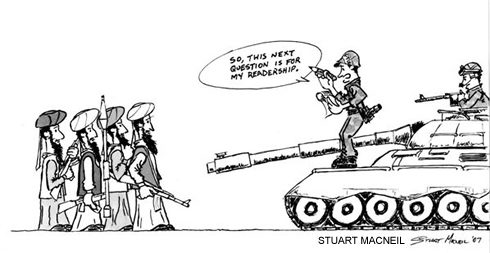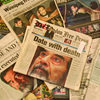Embedding for Safety?
The vicious cycle that keeps journalists unsafe in war zones
 “The 21st century is shaping up to be the most difficult period for journalists who work in war zones.” — Adnan Khan, freelance journalist, currently reporting in Afghanistan.
“The 21st century is shaping up to be the most difficult period for journalists who work in war zones.” — Adnan Khan, freelance journalist, currently reporting in Afghanistan.
While the debate continues to rage about whether or not embedding is good or bad, ethical or unethical, better or worse than unilateral reporting, most of the arguments focus on whether or not journalists can report objectively on the military if they’re relying on it for protection and using its members as sources. Often glossed over is the fact that embedded and unilateral journalists serve important but very different roles—both crucial to providing the public with an accurate and complete picture of the war. The Canadian Forces have managed to create an embed program that appears less restrictive than other countries’ embed programs – letting media workers go on and off the base freely. But even so, other factors are making it less appealing for journalists to pursue stories unilaterally in Afghanistan – a country that is becoming increasingly dangerous for media workers. Some Canadian freelancers fear the very act of embedding, a trend that is on the rise, will only increase the danger.
The term embedded became a media buzzword in 2003 when the U.S. invaded Iraq. To be an embedded journalist meant to stay and travel with the military under their protection, whereas unilateral journalists reported from conflict zones without military association. Phillip Knightley, former reporter for The Sunday Times (1965-1985), now a freelance journalist, says using the term embedding is a “smart new PR game” which tries to disguise censorship. He has been writing about wars and propaganda for more than 30 years, and backs up his argument saying, the first modern war correspondent, William Howard Russell, “was embedded with the British Forces in Crimea in that he was there under tolerance from the military.”
The level of media access to the military in conflict zones has varied from war to war; there is an almost constant push and pull between the two. But according to Knightley, “The basic fact is that the aims of the military and the media are irreconcilable.”
During the Persian Gulf War in 1991, for example, media coverage was “tightly controlled through censorship, pool reporting, and press conferences…[and] much of the press information on the war came from frequent military briefings,” according to Shahira Fahmy and Thomas Johnson in “How We Performed,” fromJournalism andMass Communication Quarterly. This was the United States’ reaction to its mistakes during the Vietnam War, when it had encouraged the media to publicize as much as possible to show the world how it was standing up to Communism. The war was virtually uncensored, Knightley believes. “This plan worked while the war was going well for America but collapsed when it began to go badly,” he says. “In the end the military decided that the media had failed to ‘get on side’ and its negative reporting cost the United States the war and it would never allow that to happen again.”
In 2003 when the U.S. invaded Iraq, the government created the embed system, which was designed to bring about greater military-news cooperation. It was as if the tight reins on coverage during the Persian Gulf War were being loosened once again, perhaps as the media pushed back. More than 600 journalists were placed with front line and rear echelon units from the start of the war through 2005. They were promised interviews would be on the record, and they would have access to service members and operational combat missions.
Although the Canadian Forces (CF) have been embedding journalists (without calling it that) since they went to East Timor, more journalists are embedding than ever before, says Capt. Doug MacNair, public affairs officer at the Canadian Expeditionary Force Command Headquarters (CEFCOM). Right now, southern Afghanistan is the only place where the CF takes embeds. Currently, there are approximately 15 reporters embedded with the CF from eight major Canadian media outlets, including CTV, CP, CanWest, Global, CBC, and The Globe and Mail. With space for 16 reporters, spots in the program are in high demand by Canadian and international media institutions alike. MacNair says the number of embeds has increased from 21 over a six-month period in 2003 to an average of 13 on any given day currently. Most are embedded for approximately six-week rotations.
Globe writer Graeme Smith suggests the Canadian media tents are often filled to capacity because “the Canadian embedding program has a good reputation among my colleagues in the foreign media. It offers a window on the conflict in southern Afghanistan with fewer restrictions than some other options.” MacNair echoes this sentiment. “The U.S. philosophy is that once you embed with an operational unit you cannot leave until that embed stint is over. They allow no loitering at Kandahar Airfield,” he says. He says the CF program allows embedded reporters to leave the base to do unilateral reporting and come back at any time. “Graeme Smith meets with the Taliban and then comes back and sleeps with us at the base,” says MacNair. “How weird is that?” He doesn’t see a problem with it “as long as they don’t take [Smith] hostage or put a bomb in his bag.”
And Smith himself has no issues with straying outside the comfort of the base, and in fact makes it a priority. “Everybody makes their own decisions about risk,” he says. “I’ve been followed, bombed and shot at with AK-47s and RPGs. Earlier this year, masked gunmen kicked in the door of my office in Kandahar city and searched the place. Still, I’m spending the majority of my days away from the military base because that’s how I find the best information.”
Not every journalist, however, wants to take such risks to get stories, particularly when there have been such definite indicators of danger. In March 2002, Kathleen Kenna, a former journalist for the Toronto Star, was badly injured while reporting in Afghanistan when a grenade was thrown into her car. Thus, the benefits for embedding are clear.
Mitch Potter, a Star reporter who embedded in Afghanistan in September of last year, emphasizes the importance of the CF program. “I think it’s important we know how Canadian dollars are being spent, and how the Canadian effort is being managed on the ground.” But like Smith, Potter always does unilateral reporting in addition to writing about the military. He says journalists who only report from the base severely limit their ability to tell the larger story. He calls this practice “lobotomy journalism.”
Bill Roggio, a renowned blogger on conflict zones who served in the U.S. Army and the New Jersey National Guard and has since embedded with both the U.S. and Canadian forces, whole-heartedly supports embedding but acknowledges, “If you want to cover what the Afghan person thinks about the war then probably embedding with a unit may not be the best place to do it.”
Adnan Khan, a freelance journalist who’s been published in Maclean’s and The Walrus, agrees. He says, “Once journalists embed the range of stories available to them narrows, along with it the range of perspectives they can give on the war.” Although Khan has been both an embed and a unilateral, he believes embedding is one of the reasons war reporting is becoming increasingly difficult. “Journalists are no longer viewed as independent. They are the ‘tools of the occupiers’ or worse, spies…There’s nothing worse than being labelled a spy in Iraq or Afghanistan and the embedding process has only served to strengthen the perception that journalists are spies.”
However, the fact that Afghans are suspicious of journalists is not a new thing, says Smith, because “spies and assassins have often pretended to be reporters.” Smith adds, “The covert wars of the last three decades have also taken a toll on the Afghan capacity for trust in general. I don’t see any recent increase in the mistrust of journalists.”
Still Khan is convinced mistrust has increased since he started working in Afghanistan five years ago. He says that in the summer of 2002 there were at least a few journalists driving around Afghanistan independently. Now that rarely happens. Another sign, he says, is that fewer journalists in Iraq plaster their vehicles with press signs when it used to be commonplace. War reporting is caught in a vicious cycle, says Khan. “The more journalists are perceived as enemy agents, the more dangerous it is for them, and therefore, the more likely they are to embed.”
Kathy Gannon, a Canadian who lives and works in Pakistan as bureau chief designate for The Associated Press, echoes Khan’s concerns. While reporting in Iraq, she saw firsthand the suspicion locals had. “When an embedded journalist came in with the military to question some people, the person I was talking to suddenly stopped talking when he saw the uniform person walk in. I had to end my interview because I realized I wouldn’t get anything more from him…[This] meant [the other journalist] would only hear what that person wanted the U.S. military to hear.” She says the people in Afghanistan won’t say what they are truly thinking when the military is around because they are afraid.
Potter of the Star agrees. “The likelihood that you’re going to get an honest answer from an Afghan is much less likely if you’re standing beside a soldier. I think that’s the larger concern.” Gannon believes the embed program blurs the role of journalists in the minds of local people in countries such as Iraq and Afghanistan. “If we are seen as part and parcel of the military then we become fair game. It has always been critical that journalists not be armed, not be affiliated, associated with anyone. That line has been blurred with embeds…” She says this has made it more difficult and dangerous for journalists.
So embedding would seem to be the obvious solution in order to stay safe while still getting stories. But if embedding makes local people in those countries suspicious of journalists and that mistrust sets journalists up as targets for violence, the media looses access to important stories. And so the vicious cycle continues…
by Lisa Paul
Lisa Paul was the Chief Copy Editor for the Spring 2007 issue of the Ryerson Review of Journalism.












































